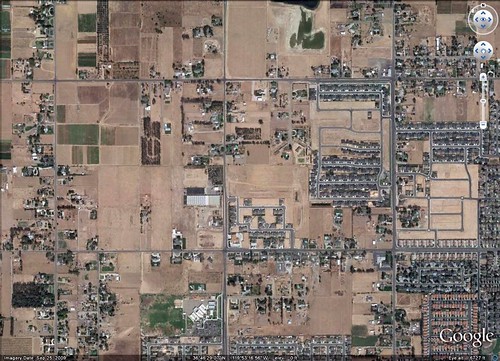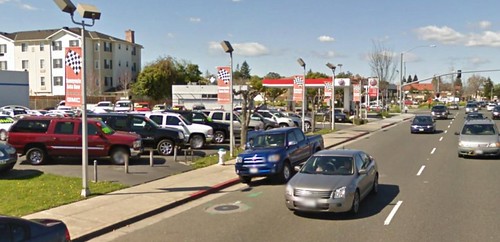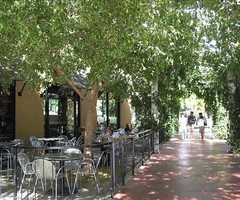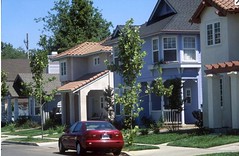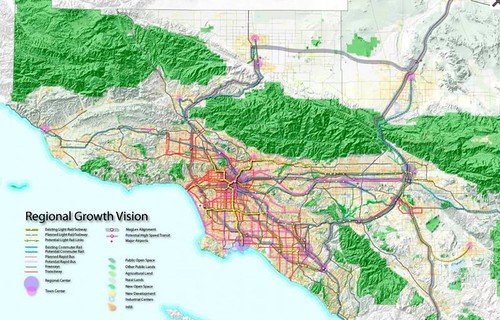New California report shows well-planned land use could dramatically reduce pollution, household costs

Posted June 24, 2010 at 1:00PM
A new state-sponsored report reveals that smart planning could bring dramatic environmental and economic benefits to California, while troubling consquences are likely to result if recent trends are allowed to continue. The findings have implications outside of California as well. I'll share some numbers from the report below but, first, the context:
Like other places in America, our nation’s most populous state (and the birthplace of modern suburban sprawl) is facing the task of accommodating susbtantial new population and economic growth over the coming decades, the current recession notwithstanding. This raises fundamental choices. Should the state continue on the course that has led to haphazard growth patterns like this?
Or can California apply its considerable talent and resources to create well-considered neighborhoods and regional planning exercises like these?
NRDC believes that California (and other states) would have much to gain from a more conscientious approach to land use and growth management. Indeed, analysis of the potential benefits already has been pioneered locally in the Sacramento area, and similar efforts to address carbon pollution reduction through land use and transportation strategies in other metropolitan regions are now required under state law and will be taking place over the next several years.
The new report brings this thinking to the statewide scale, and its careful analysis shows an impressive upside to thoughtful planning under a "growing smart" scenario:
- By reducing the length and number of car trips that will be required of Californians if nothing is done, the smarter scenario could reduce cumulative driving by 3.7 trillion miles by 2050, or the equivalent of taking ALL cars off California roads for 12 years.
- This could save 140 billion gallons of gasoline through 2050, reducing oil consumption by an amount roughly equivalent to seven years’ worth of all US offshore oil production. Put another way, the state could save enough oil to avoid two years’ worth of current US oil imports.
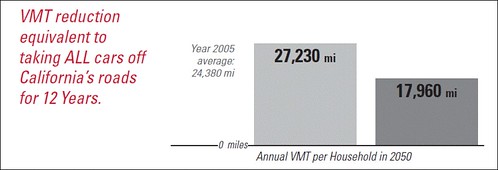
- By building more energy-efficient homes and workplaces, California could save enough energy by 2050 to power every current home in the state for 8 years.
- Compared to doing nothing to alter current trends, California households could save an average of $6,400 annually on transportation and utility costs because more people would be able to drive less and live in homes that use less water and energy.
- Californians could save some 3,700 square miles of farmland, forests, recreation areas, and other currently open space that would be lost under business as usual.
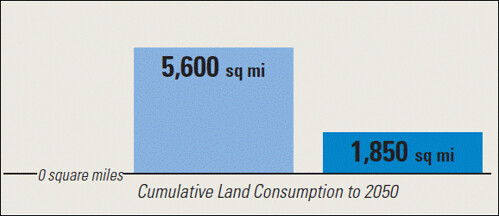
- The state could reduce greenhouse gas emissions by 25 percent, avoiding the release of 70 million metric tons of carbon dioxide into the atmosphere in 2050.
- Cities and counties could save $4.3 billion annually on infrastructure costs by building more compact neighborhoods.
- Through efficiency measures, the state could save enough water by 2050 to fill the famous Hetch Hetchy Reservoir in Yosemite National Park more than 50 times.
These very impressive findings come from Vision California, a scenario planning exercise that is comparing alternate strategies for accommodating an additional 60 million people and 24 million jobs expected to be absorbed into the Golden State by 2050. Funded by the California High Speed Rail Authority in partnership with the Strategic Growth Council (a cabinet-level, statutorily mandated committee), the exercise has also been developing two new modeling tools to formulate and compare scenarios. Vision California is being led by the highly respected urban design and planning firm, Calthorpe Associates.
“California is leading the nation in tackling smart and comprehensive land-use planning that will help us lay a foundation for economic growth, improve our quality of life and meet our environmental and health goals," said Governor Arnold Schwarzenegger, in a press release on the new findings. “This analysis shows we are moving in the right direction in working to design communities that allow Californians to save money by spending less time in their cars and more time with their families. By working together at all levels of government, we can help create a brighter, more sustainable future for generations of Californians to enjoy.”
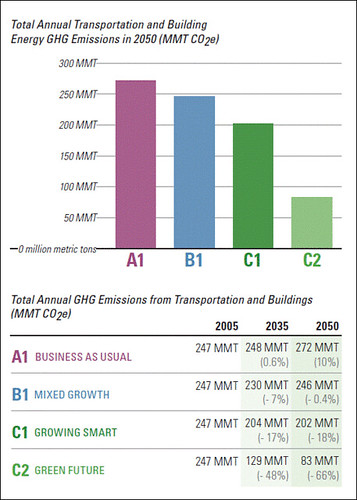 The analysis is contained in Charting our Future, the first report from Vision California. It compares the effects of a business-as-usual scenario, which assumes a continuation of dispersed, auto-oriented development patterns (albeit with continued modest improvements in automobile, building, and energy generation efficiency), against the growing smart scenario, which assumes a more balanced housing mix, more infill development, and greater transportation options.
The analysis is contained in Charting our Future, the first report from Vision California. It compares the effects of a business-as-usual scenario, which assumes a continuation of dispersed, auto-oriented development patterns (albeit with continued modest improvements in automobile, building, and energy generation efficiency), against the growing smart scenario, which assumes a more balanced housing mix, more infill development, and greater transportation options.
The exercise also analyzed two other scenarios, including an ambitious “green future” concept that coupled the land use assumptions in the growing smart scenario with “leading-edge policies for vehicle fuel economy, the carbon intensity of fuel, building energy and water efficiency, and the proportion of renewable resources used by utilities in their power generation portfolio.” The authors chose to omit the findings for this scenario from their summary document (along with those for a “mixed growth” scenario).
I wish they hadn’t. The ‘green future” alternative would achieve all of the savings from the growing smart option while, in addition, reducing gasoline, oil consumption and driving costs by another 20 percent, greenhouse gas emissions by another 70 percent (see chart just above), building energy use by another 30 percent or so, and water consumption by another 35 percent below the levels modeled for the growing smart scenario. Those are impressive and important numbers and, especially when we are talking about long-range planning going four decades out from today, we should be ambitious enough to consider a more holistic set of policies and practices that can contribute to sustainability, not just those that can affect land use and transportation patterns.
Vision California’s next steps include the development of detailed statewide physical land use and transportation scenarios utilizing new mapping and analysis tools. The web site for Charting Our Future includes both the summary and the full report.
Move your cursor over the images for credit information.
